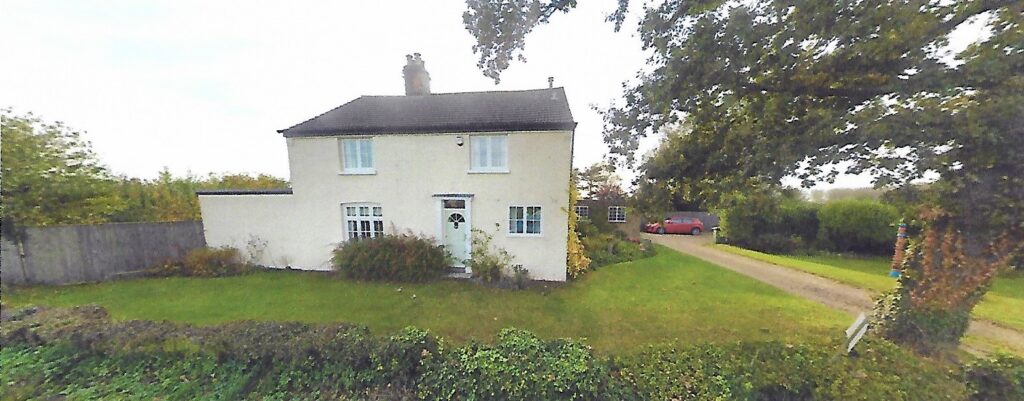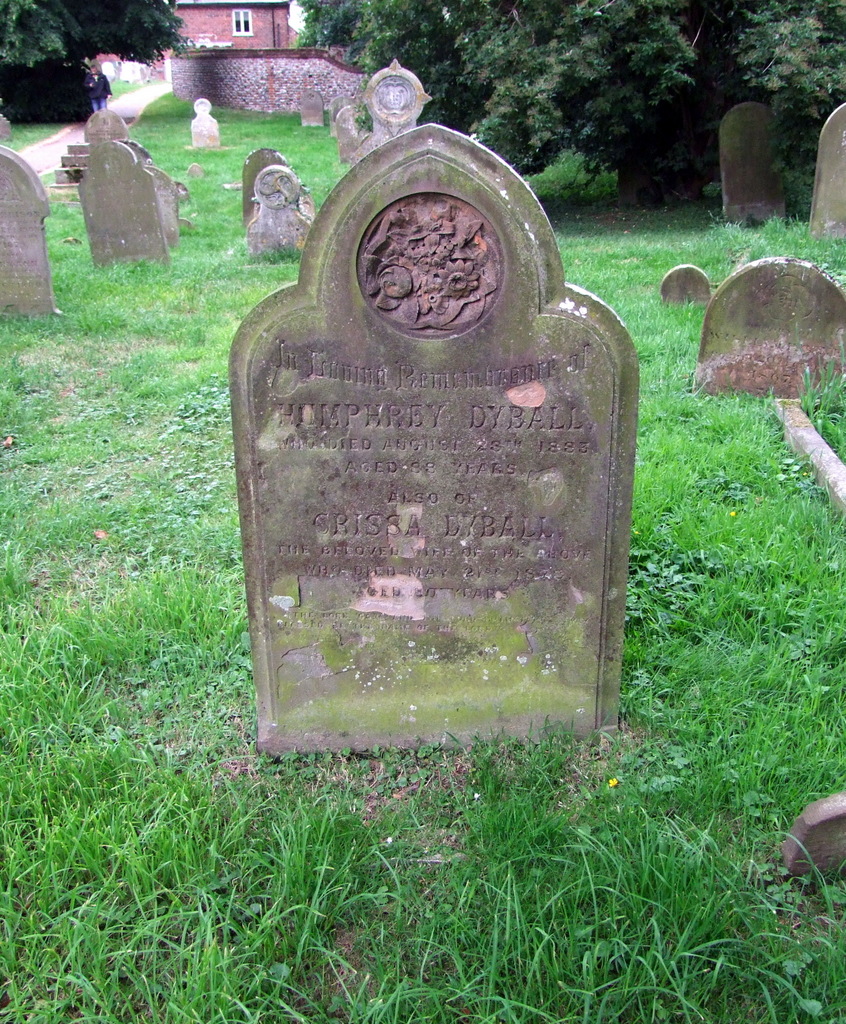Farming in Martham 1853 to 1878
Based on the diary of Humphrey Dyble 1795-1883

With acknowledgment to Barbara Cornford whose original article was printed in the Martham Magazine in September 1976 on which this is based.
Humphrey Dyball (1795-1883) was a farmer who was born in Somerton and lived and farmed in Martham most of his life. He kept a diary for twenty-five years from 1853 to 1878 and only very rarely did he fail to make an entry for any day. The diary was saved by his great grandson Thomas Dyball who was married to Violet, nee Minns and they used to live at Yew Tree Cottage.
Humphrey farmed 40 to 50 acres of arable and pasture land in Somerton and off Hemsby Road, Martham where he lived with his family for over 60 years. His status as a farmer was confirmed by his inclusion in the East Norfolk Parliamentary list of people entitled to vote on 18th July 1865.
His fields were called Somerton Field, Jolly’s Close, Home Close, Southfield, Middle Field and North Field. His main concern was growing wheat and barley which he sold to a local corn merchant called Mr Faulke, who owned Martham Mill on Hemsby Road. He also sold part of his production of hay. He grew potatoes, which he sometimes sold to sea-going boats, peas, beans and various root crops like turnips, swedes and mangolds which were all for fodder for his stock. He had three cows and their calves, some pigs and two horses. His labour consisted of himself, and in 1851 his son Thomas and in 1861 another son called William. He also hired a labourer called John Futter Gymer. Gymer was paid 1s 10d a day in 1853. The next year at the time of the Crimean War, food price were rocketing, and his wages rose to 2s a day, and by 1876 he was earning 2s 6d a day. This would mean that his weekly wage was about 12s to 15s (60p to 75p) per week for a six day week. However some of his work was done on piece rates for which he seems to have got nearly twice his usual rate. In 1854 he received £1 for 4 ½ days threshing which would have been back breaking work with a flail. Setting wheat, sowing hay and cutting thorn faggots were all paid by piece rate. John Gymer did the not unusual thing of marrying his boss’s daughter when he married Sarah Dyball at St Mary’s on 28th April 1850.
Humphrey had six arable fields that were all quite small of between five and eight acres. He usually grew three or four different crops in each field, so a typical cropping pattern would be two acres of wheat, half an acre of turnips, a row or two of potatoes and two or three acres of clover all in one field. This seems to have been the traditional system of cropping in East Norfolk. Since all his operations were carried out by horse or man power he would have seldom been able to tackle more than one acre a day for any task. This splitting up of crops does not appear to have caused him any trouble. He never ploughed more than an acre a day, nor sowed more than that. When it came to hay making and harvesting he could deal with more than an acre. He and his son-in-law, John, mowed three acres of clover with a scythe in one day in June 1856. This then had to be turned and finally heaped into thirty hay cocks, which were then carted in six loads to the hay loft or barn in the next week or so. A second crop was gathered in September.
The harvest started in August with the wheat. It was reaped with a sickle or a reaping hook, tied by hand into sheaves and stored in the field. He recorded each day’s output by the number of sheaves cut which was usually between 400 and 600. Barley was always mowed, turned and cocked like hay. He could cart two acres of corn each day, stacking it in the many corn stacks that stood about his fields. Threshing was done by hand with flails or sometimes by horse treading. Occasionally he hired a horse driven threshing machine. His entry for 12th August 1853 listed ‘Threshing a stack of wheat with Turner’s machine and with Daniel Manship and Mr Robert Wright’s horses’. After 1870 he used other methods. He borrowed a reaper to cut his wheat and cut 1,500 sheaves in a day. Three times as many as he and his son-in-law could have done by hand. In 1876 he hired a steam threshing machine on 2nd October from Robert Thurtle. For this he employed five extra men at 2s 6d a day, a boy at 2s and the two machine men at 5s 6d a day. As a result of the day’s work he thrashed a stack of wheat (54 sacks) and a stack of barely.
His diary records a very bad harvest in 1876 when there was day after day of rain with his comment ‘nothing done to forward business.’ He finally finished harvest that year on 18th September.
Genealogy
Humphrey Dyball was born in about 1795 in East Somerton, as the son of Humphrey Dyball and Elizabeth Sadler. When he was 27, he married Christina Read on 22nd February 1822 in St Nicholas Church, Great Yarmouth. She was always known as Crissa.
Humphrey was counted in the census in 1841 as living at Horsey Road, West Somerton and was an agricultural labourer. He was in the census in 1851 as living at Market Road, Martham which was the name for Hemsby Road at that time, and he was a farmer of 51 acres. He was in the census in 1861 living at Hemsby Road, Martham and was a farmer of 55 acres, employing two men. He was in the 1871 census as living at Martham (probably at Hemsby Road) and was still a farmer of 43 acres employing 3 men and one boy. In 1881 he was at Hemsby Road working his farm of 40 acres with 2 men and a boy. His wife Crissa died on 21st May 1878 and he died on 28th August 1883 aged 88. They both share a grave in St Mary the Virgin graveyard (section A, plot J2).
Humphrey & Christina had the following children:
- Humphrey Dyball was born in 1825 in Somerton. He married Martha Starkings on 15th April 1849 at St Mary’s, Martha died in 1912 and Humphrey in 1916 aged 91. They are both buried at St Mary the Virgin, section H, plot C14.
- Sarah Dyball was born about 1829 in Somerton. She married John Futter Gymer on 28th April 1850 in St Mary’s. She died on 17th December 1908 in aged 79 and is buried in an unknown plot at St Mary’s. John died on 15th February 1912 and is buried at St Mary’s at section H, plot G4.
- Thomas Dyball was born in 1831 in West Somerton. He married Maria Kerrison on 17th September 1856 at St Mary’s. She died on 11th January 1909 and Thomas died only three months later on 6th April. They share a grave at St Mary the Virgin, section H, plot G7. One of their children was a son called Edward (born 1867) and his son Thomas (born 1899) saved Humphrey’s diary which has been passed down through the family since then.
- Mary Ann Dyball was born in 1836 in Somerton. She married Robert Symonds on 17th January 1858 at St Mary’s. Robert died in 1877 and Mary in 1906. They share a grave at St Mary’s at section A, plot Q3.
- William Robert Dyball was born in 1839. He married Mary Ann Howlett on 6th September 1865 at Great Yarmouth. William died on 1st February 1924 and Mary on 9th January 1926. Their joint grave is at St Mary’s section H, plot H7.
- Hannah Dyball was born in 1840 at West Somerton. She married John Felmingham on 10th February 1861 at St Mary’s. She died young on 28th May 1870 and is buried at St Mary’s graveyard section H, plot Q4. John’s second marriage was to Sarah Ann Copeman. He died in Great Yarmouth in 1916.
